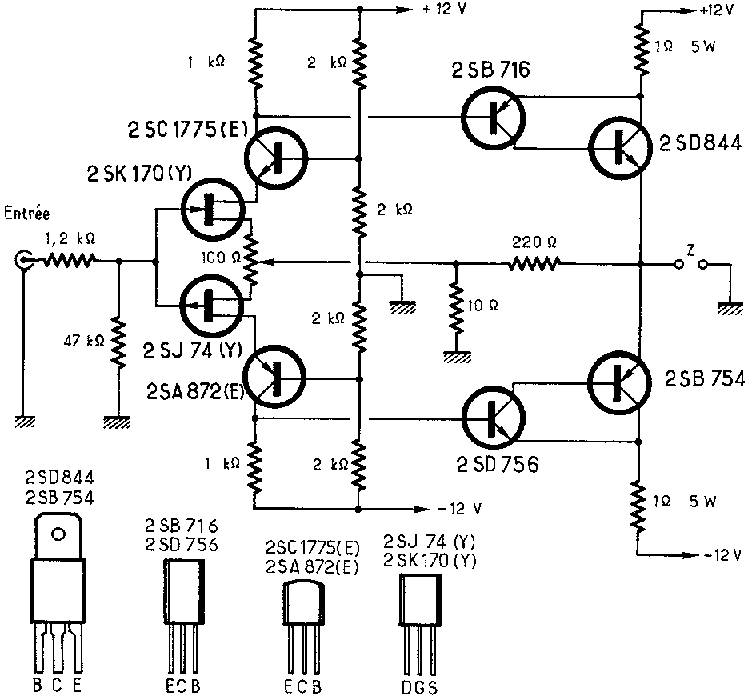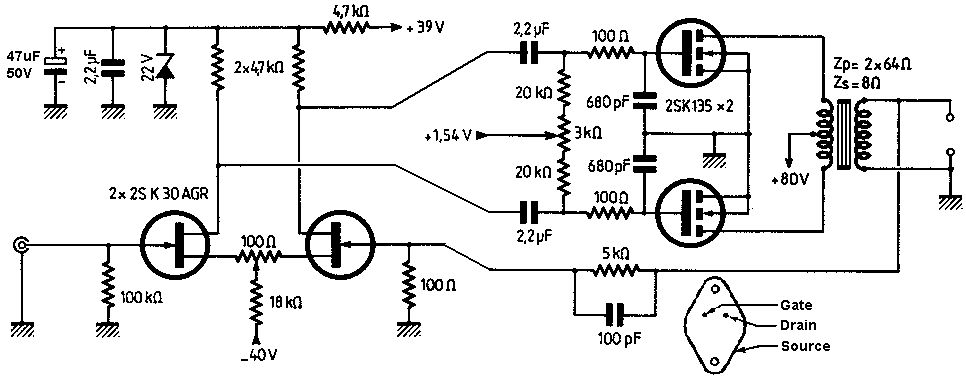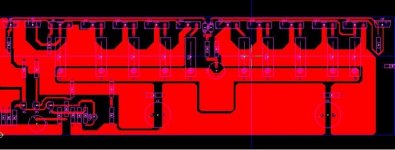zagisrule! said:What discrete amp can you make for under $250 USD?
This one....the one I have been playing with as designed by Ken Anderson. Picture is blurry, I will post again with files tommorrow when I am not so tired.
Seems like it might make sense to post the updated pictures on the Solid State forum with a pointer to that thread from this thread. There will probably be interest there as well.
What discrete amp can you make for under $250 USD?
i made several Zen variations and they all were < 250€
moving_electron said:Sreten,
In your experience, what speaker efficiency would be required with a 10w class A amp if:
1) the goal was to be able to play music reasonably loud occasionally (would have to speak fairly loud to talk to a nearby person but not have to shout)
and
2) lower frequencies were handled by a sub crossed over at 80hz
What if there were stereo subs instead crossed over at 150Hz or 200Hz?
My experience of low power class A (Sudgen and the classic
now defunct Kelvin Labs) is that they frustratingly give up
the ghost on low bass, midrange levels are fine and handling
of complex midrange transient levels stunning.
I can't comment on speaker sensitivity as it depends on very
subjective appraisal of what is loud enough and room size.
But IMO a 3 way with an active c/o bass to mid and passive
mid/treble with a good 40W bass amplifier and 15W class A
for mid/treble would be surprisingly capable using decent
drive units of reasonable sensitivity, ~ 89dB/W.
Bass/ mid c/o would be ~ 200Hz,
active BSC should be applied to the mid unit.
zagisrule! said:Bottom line: I have heard GC as I said. I was not impressed and that is my opinion. Why would it make any difference to build it yourself and call the exact same thing better? I realize that parts, PCB layout and such play a part, but how much different is it really?
I don't have anything against an opinion, as we are all entitled to it and these forums are based on that.
There's a huge difference on how to build a project using these chips and making it a lot better.
Let me tell you my experience: a friend of mine and me built two different GC. His was based on an Elektor's pcb design, non inverted; mine I designed myself, inverted. Both used 3886 chips. His was powered by +/-35v using 2200uF caps; mine was powered by +/-24v using 1000uF caps.
The one I did made rings around the other, but both of them made a lot of improvement over a good quality JVC power amp, discrete.
If you say: I listened to a GC (inverted or not) built following most of the guidelines you guys say make a difference, and I didn't find it that good. That's an opinion based on discussing similar things. If those rules do not apply it's a different game.
Carlos
Does anyone in NM have a GC? So that I could hear one and then truley have a valid opinion on the topic? Perhaps we compare to one of my discrete units I have under construction?
I will post the stuff up in solid state later today.
Like till said, pretty much anything can be made for under $250USD. The only project I am doing currently that exceeds that price (will cost me around $300, most expense in transformer and heatsinks) is my 250W "Mosnter"...as the PCB pictures below:
-Matt
I will post the stuff up in solid state later today.
Like till said, pretty much anything can be made for under $250USD. The only project I am doing currently that exceeds that price (will cost me around $300, most expense in transformer and heatsinks) is my 250W "Mosnter"...as the PCB pictures below:
-Matt
Attachments
Hi Angel.
OK, It's true that $250 is easy to spend, even on a gainclone.
I made a Brian clone and this is how it worked out in USD:
Deluxe boards and parts: 60.00
330 VA toroid 50.00
Par case 65.00
attenuator 2.50
knob 5.00
DPDT selector & spkr term. 2.00
RCA jacks, etc I had.
SO with shipping I spent about $200
Note that all the cost is the box and knob, etc.
BUT, you may remember the amps that Blue Circle was making in a pair of women's shoes!!
SO, Often women don't want a big metal box in their rooms.
MAYBE she has a pretty wooden box or something similar sitting on her furniture that you could put a gainclone in. Or go to an import store looking for decorative metal or wood boxes.
Matching the box with a knob is a good test of your design
skills. Drawer pulls often work well.
The clones put out so little heat that leaving the cover spaced open a little and/ or putting holes top and bottom on the back, will be enough as long as you have a heatsink inside. Or put the heatsinks on the back. Make sure you can cut it up like that!!
If she only uses a CD player, than no selector, so that's a savings also. Now if you can find a surplus transformer, you are down to under $100.
Anyway, I built my amp for my son, and when you are making things for others the most important thing is that it works, and works well!! They are not impressed if they have to wait and wait for an amp with 2% better sound (probably not even that) , or that blows up!!!
Better not to spend so much time making it and more time with her!
For friends and family, gainclones are the way to go!!!
The sound is very very good. Read over all the gainclone threads and see the many people that are surprised at the very high quality of sound.
Save the exotic, hot, amps for yourself. I am making a Son of Zen for myself, but that isn't what most people want!!
OK, It's true that $250 is easy to spend, even on a gainclone.
I made a Brian clone and this is how it worked out in USD:
Deluxe boards and parts: 60.00
330 VA toroid 50.00
Par case 65.00
attenuator 2.50
knob 5.00
DPDT selector & spkr term. 2.00
RCA jacks, etc I had.
SO with shipping I spent about $200
Note that all the cost is the box and knob, etc.
BUT, you may remember the amps that Blue Circle was making in a pair of women's shoes!!
SO, Often women don't want a big metal box in their rooms.
MAYBE she has a pretty wooden box or something similar sitting on her furniture that you could put a gainclone in. Or go to an import store looking for decorative metal or wood boxes.
Matching the box with a knob is a good test of your design
skills. Drawer pulls often work well.
The clones put out so little heat that leaving the cover spaced open a little and/ or putting holes top and bottom on the back, will be enough as long as you have a heatsink inside. Or put the heatsinks on the back. Make sure you can cut it up like that!!
If she only uses a CD player, than no selector, so that's a savings also. Now if you can find a surplus transformer, you are down to under $100.
Anyway, I built my amp for my son, and when you are making things for others the most important thing is that it works, and works well!! They are not impressed if they have to wait and wait for an amp with 2% better sound (probably not even that) , or that blows up!!!
Better not to spend so much time making it and more time with her!
For friends and family, gainclones are the way to go!!!
The sound is very very good. Read over all the gainclone threads and see the many people that are surprised at the very high quality of sound.
Save the exotic, hot, amps for yourself. I am making a Son of Zen for myself, but that isn't what most people want!!
sreten said:
active BSC should be applied to the mid unit.
sreten.
I remember seeing a claim that a BSC or notch should go before the crossover so that the phase effects of BSC or notch are applied to both the low pass and high pass. Otherwise the woofer would have a different phase from the mid at the crossover frequency point.
That was the claim as I remember it anyway.
zagisrule! said:Bottom line: I have heard GC as I said. I was not impressed and that is my opinion. Why would it make any difference to build it yourself and call the exact same thing better? I realize that parts, PCB layout and such play a part, but how much different is it really?
Be careful, some guys (and manufacturers) can make these very good chips sound really bad...
moving_electron said:
I remember seeing a claim that a BSC or notch should go before the crossover so that the phase effects of BSC or notch are applied to both the low pass and high pass. Otherwise the woofer would have a different phase from the mid at the crossover frequency point.
That was the claim as I remember it anyway.
True, especially if a higher than 200Hz frequency is used.
Really depends on your approach and the order of the c/o
between bass and midrange, but for 200Hz c/o BSC only
needs to be effectively applied to the mid unit.
It is probably easier to simply crossover the two units
and precede the active crosovers with passive BSC.
Konnichiwa,
Well, if you want something that has an extremely high likelyhood of working first time, sounding rather notably above average and which is fairly quick, the gainclone abso-effing-lutely fits the bill and it will be VERY HARD to beat in those terms.
Now if you can handle selecting individual FET's and transistors (and reselling the "spares") and building fairly complex discrete circuits, adjusting them and so on, there is the possibility to (IMHO) better gainclones. I'd look at either the Monstre or Hirage 20 Watt unless you want to be really experimental and build a PP Mosfet Amp WITH OUTPUT TRANSFORMER.
Hiraga 20Watt
Hiraga 20 Watt

Hiraga Le Monstre 8 Watt

And finally the "Nemesis PP" which can use a 115V+115V:40V+40V 300VA mains torroid as output transformer
More info on the general "Nemesis" range from l'Audiophile including PSU is here...

Sayonara
angel said:I'm looking to build a cheap ~2x10Wrms@4ohm amp for a friend of mine, and am wondering whether a gainclone or discrete design would be likely to give the best price/performance tradeoff below ~USD250. 4x5Wrms would also do the trick.
<snip>
I have prior experience with constructing amps, and think I've cut off many of my thumbs by nowrolleyes
, but I'd like to avoid surface mounting if possible.
Well, if you want something that has an extremely high likelyhood of working first time, sounding rather notably above average and which is fairly quick, the gainclone abso-effing-lutely fits the bill and it will be VERY HARD to beat in those terms.
Now if you can handle selecting individual FET's and transistors (and reselling the "spares") and building fairly complex discrete circuits, adjusting them and so on, there is the possibility to (IMHO) better gainclones. I'd look at either the Monstre or Hirage 20 Watt unless you want to be really experimental and build a PP Mosfet Amp WITH OUTPUT TRANSFORMER.
Hiraga 20Watt
Hiraga 20 Watt

Hiraga Le Monstre 8 Watt

And finally the "Nemesis PP" which can use a 115V+115V:40V+40V 300VA mains torroid as output transformer
More info on the general "Nemesis" range from l'Audiophile including PSU is here...

Sayonara
sreten said:
True, especially if a higher than 200Hz frequency is used.
Makes sense. I assume this is because the phase shift from the BSC circuit is 0 at 0HZ and only is an issue when the frequency is near where the compensation kicks in.
This statement :
sreten said:
Really depends on your approach and the order of the c/o
between bass and midrange, but for 200Hz c/o BSC only
needs to be effectively applied to the mid unit.
Does not seem to fit with:
sreten said:
It is probably easier to simply crossover the two units
and precede the active crosovers with passive BSC.
sreten.
Did you mean to say: "It is probably easier to simply crossover the two units and follow the active crossovers with passive BSC."?

sreten said:No. The third statement is very general for any c/o frequency and slopes.
sreten.
Oh. OK.
So I interpret it as a passive line level BSC before the active crossover works fine (and is easy) and an active (such as opamp based) BSC is likely not really needed.
- Status
- This old topic is closed. If you want to reopen this topic, contact a moderator using the "Report Post" button.
- Home
- Amplifiers
- Chip Amps
- Low cost gainclone vs discrete
